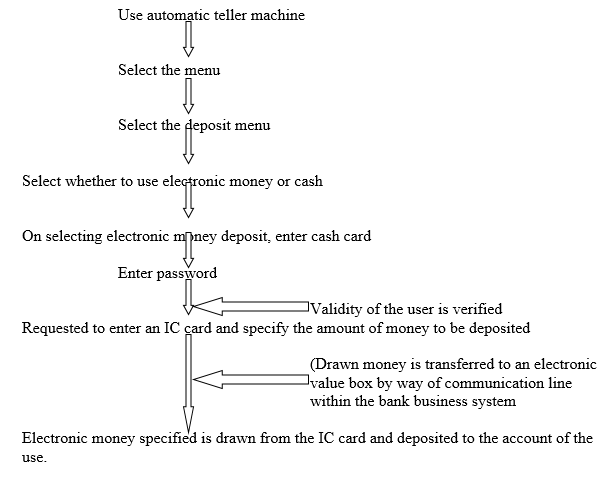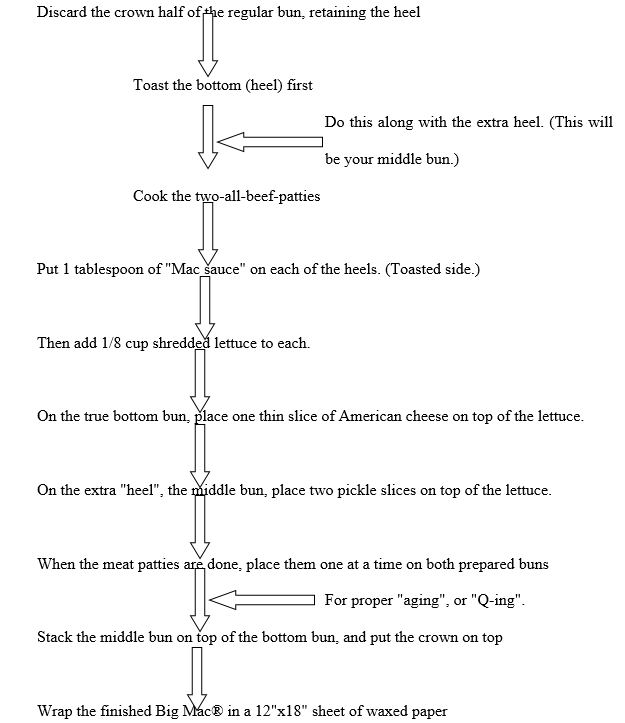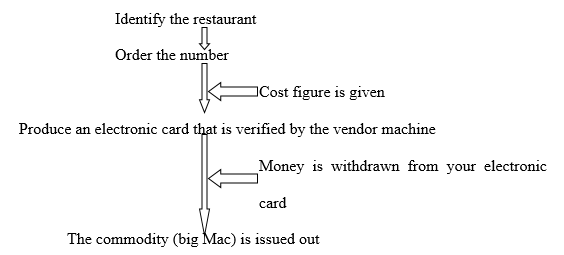Introduction
Technology provides the management with an option to change their businesses processes in order to improve on efficiency and quality. But it’s only half of the effort that will have things done in a better, faster and easier way. Its maximum benefits are felt when business processes are improved. When incorporated into the business, instant benefits are seen. An example is, through scanning documents or writing an email, business management is able to get in touch with clients and customers instantly, Christensen, C.M. (1999).
Processes of an organization
A business process model is a flowchart that gives out the workflow within an organization. Beyond speed that is attributed to technology, processing of information is vital. As technology allow for scanning of documents into pdfs, it creates an opportunity to improve the general internal process of that incoming mail. To visualize the different steps of a process, graphical shapes are used. One example of the steps of a process is; what initiates the start or stop of a process; events that take place along the way; decisions made that can change the process path. For example, in a hospital set up when a patient is making his/her first visit, the registration of the patient will involve a set of specialized tasks, Dent, E. & Goldberg, S. (1999).
Business Process Modeling Notation (BPMN) that is emerging from Object Management Group (OMG) is getting the favor of various organizations. It makes use of graphics that are commonly understood as well as familiar to most of the average business users.
The graphics in the process model have different meaning. A circle may represent the start of a process, and boxes may represent tasks or steps within the procedure. A decision point that causes branching in the process flow or a gateway maybe represented by a diamond. Arrows are used to show direction of the flow and a dotted arrow is used to show that a message has been issued out between the parties.
Message flows usually have information or data that is created, read, updated or deleted. BPMN has the advantage of allowing extensions and the representations of other specific data objects. In a hospital set up for example, upon the registration of a patient, the patient database is updated. Organizations have the tendency of using CRUD reports where the initials stand for created, read, updated and deleted respectively, Christensen, C.M. (1999).
“A picture paints a thousand words” is a common saying that has its truth also in the use of business process model. Multiple constituencies within the organization are able to understand the general workflow by visualizing the graphical representation of the process. Even the process of creating the model itself is intuitive as it gives an analysis and insight on the way that the organization is operating which would not be easily understood without the model. Documentation of organizations affairs in a model makes it far much easier to asses areas that need to be optimized. Some modeling tools have simulation capabilities that provide a process flow visual indicator as well as provide analysis and metrics that are used to determine factors such as where resources need to be added or even removed.
Organizations that use a service-oriented architecture (SOA), business process models can be used to incorporate an orchestration mechanism for web services that run automated processes. It is possible to map BPMN into execution languages such as BPEL (business process execution language, from the OASIS consortium). This lets the model show the real time processes taking place within the organization thus ensuring efficiency, consistency as well as automation of the important workflow, Dent, E. & Goldberg, S. (1999).
Technology’s role in improving processes
Nearly every technology implemented within the office, creates opportunities that improve business processes and thus increase the users capability to compete effectively in the general market. Soon, the industrial age processes will be obsolete and the businesses that are most competitive will be those that will merge process and technology. New forms of business will be created altogether, Quinn, J.B. (2005).
Technology is appreciated in many aspects within the office. Example is the process of mailing internally. As nearly every organization has to process mail, most of them have developed a sorting and routing internal process. When this mail is composed and set forth in a format such as PDF, it’s usually routed out to team members, customers and to clients. When a mail is received, it’s usually saved in an incoming mail folder, reviewed, scanned and then routed by email. In these instances, specific dates and tasks to be done have to be retrieved from the incoming mail then entered into the task system and into the calendar schedules. Irrespective of whether the incoming mail is electronic like PDF or paper, all these processes have to take place.
In a digital world with an improved process the same piece of mail can be looked on differently. With a document routing coversheet, the mail is handled differently. This includes information such as task lists and calendar dates. The decision maker in the document is also able to select the method of routing such as by email, fax, mail, fed ex as well as other available means. The decision maker receives the routing sheet and the hard copy and is able to dictate tasks to be taken. After documentations of the tasks and functions to take place, the document is sent to the scanning room, Quinn, J.B. (2005).
Technology in the above example has allowed a PDF format of the document to be created and thus the review of the document is significantly improved. The routine cover sheet provides a uniform structure in a way all incoming mails are handled. The person in charge of the document is able to dictate tasks that arise out of the document review which are then transcribed into the to-do system of the company. This system ensures that the probability of forgetting the to-do items is eliminated. Ability to prioritize some of the very important tasks in the document so that they are handled immediately is part of the process.
Inputs and out puts of a process
Initially, a linear production is used to present an organization where inputs are eventually converted into outputs. In order to transact with the outside world, organizational outcomes and outputs generate services, information, products as well as other resources. They also make performance information available which enables sustainability of the organization through knowledge base and organization memory.
Organization inputs on the other hand consume resources that are generated by the environment. It also takes up feedback from the organization on clients’ needs and production requirements. To balance order and chaos, feedback loops are highly crucial. Organization production processes imitate the general environments technologies and are governed by the operating organization configuration. This organization configuration refers to systems, structures, strategies culture and style, Dent, E. & Goldberg, S. (1999).
Organizations could be referred to as transforming systems. Through processes designed for transformation or conversion, inputs are changed into desirable outcomes. In the following example, arrows represent activity and energy flow in the organization. They thus represent the changing nature of the system. The feedback loops represent learning that is occurring in the organization within the system level. There are two types of learning loop. Single-loop learning and the double-loop learning. In single loop learning, errors are detected and corrected as per the rules of the current organizational memory and configuration.
Double-loop learning takes place when organization memory and configuration are under challenge. Thus the management’s role is to regulate the system by the use of organizational memory and configuration in order to attain the required results. Demand and supply are the two forces that managers try to balance and an equilibrium is achieved when the two are matched, Hatch, M.J. (1997).
Example of processes
Depositing money using an electronic card

Making a Big Mac

Buying a sandwich/ Big Mac

Getting to class

Conclusion
There is a sure relationship between structure, strategy technology and the processes that interlink them. Failure of companies to change will see them forfeit a bright future. Since both technology and processes involve change, implementing this change would require a winning strategy. This is so because often, organization change is usually resisted either at the individual, departmental or at the system level. Technology use both in the manufacturing sector and in the service industries is the most likely key to future productivity and wealth.
In order to survive, organizations must adapt to the changing technological environment. Organizations are classified as open systems that interact directly with the surrounding environment. They have inputs such as finance, raw materials and new recruits as well as outputs such as services provided and products, wages and dividends. Inputs are transformed into outputs by the human resource power with the use of technology. There are various implications to the organizations associated with high technology. These may include loss of jobs due to increased automation, increased productivity and increased enthusiasm to develop more of such technologies, Quinn, J.B. (2005).
To be able implement best practices and improve auditing, process model should be utilized. Detailed models that outline best-practice-driven workflow, responsibilities and roles are one of the ways an organization can meet its goals effectively. This cannot happen without change which in most case is characterized by resistance. It’s thus of paramount importance that the management does execute change professionally by carefully studying behaviors associated with resistance to change in order to come up with ways to overcome it.
Reference
Dent, E. & Goldberg, S. 1999. Challenging “resistance to change.” Journal of Applied Behavioral Science, 25-41.
Quinn, J.B. 2005. The intelligent enterprise: A new paradigm. The Academy of Management Executive, 19(4), 109-121.
Christensen, C.M. 1999. Innovation and the general manager. Boston, MA: Irwin McGraw-Hill.
Hatch, M.J. 1997. Organizational theory: Modern, symbolic, and postmodern Perspectives. Oxford, UK: Oxford University Press.